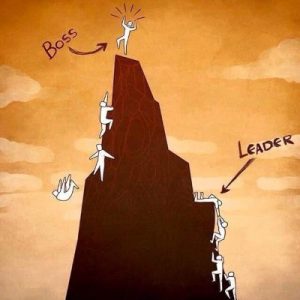Leaders and leadership
As part of my journey to being a Learning Technologist, and beyond this role into management and leadership (more on this soon), I have often written and spoken about how us technologists become more visible and respected in the eyes of our academic colleagues. Many of us in our roles do not have the kinds of qualifications academics that they recognise (Masters degrees, etc.) nor do some of us have either the time, inclination or finances to go down this route. From the outset of joining ALT I was interested in CMALT and then gained the qualification, worked towards gaining it and then the three-year renewal process.
How many of us have seen the image below before? The ‘leader’ as someone who is helping and guiding their team to the top in an inclusive and engaging way. Often not the first to the top, often not even reaching the top either, but ensuring no one on the team is left behind and that credit is given to the team for their collective achievements.
The ‘manager’ or ‘boss’ is someone here who may lead from the front, maybe even thinking they’re showing strong leadership and acting as a role model for their team to follow in their footsteps.
[bctt tweet=”Do you manage or lead? Do you want a manager or leader?” username=”hopkinsdavid”]
This may be a gross over-simplification of the two roles, but which would you rather work with? Who would you rather work for? Which environment seems more likely to produce a collegiate or enthusiastic workforce. Which looks like it’ll produce a resentful or dispassionate team?
I have known many people who fit both these roles, personally and professionally, as well as managers and leaders who exhibit characteristics of both generalisations above. Have you? So, what makes a good leader or manager?
I don’t know. Other than knowing the kind of leader and manager I want to be, it’s all a bit grey-scale to me. How do we grow in the role, grow the team, grow the sense of wellbeing and belonging that we want to feel ourselves, and therefore what we want from the team, how do we do this?
As someone who identifies as an introvert, this isn’t always easy to explain. In fact, thanks to some harsh and very wrong words from a couple of school teachers I always through being an introvert was something to be ashamed of, something less than ‘whole’. I’ve since found an introvert is someone who finds the strength for the day or task ahead from within … indeed a quick google search shows the definition of “a shy, reticent person”. This cannot be further from the truth. I am not shy, I just won’t compete for your time or energy; I have my own and I’m quite happy with it. I may need to recharge more often, but this is simply time I need for myself to reflect and reengage.
In the past few years I’ve learned actually that introverts, and being introverted, is something to be proud of, something that gives me an inner strength that enables me to do more than I thought I could, and more than you thought I could, especially as a leader! Introverts as leaders are a powerful voice, often drowned in the general melee of meetings and gatherings, but you can be sure of one things .. when we’ve something to say it is carefully thought out, carefully planned, and right on the button!
Many meetings are controlled by people with lots to say, often never stopping long enough to listen. But the silence of others in the room shouldn’t be taken as that they’ve nothing to say, it’s as much the fault of those talking in that they never leave any time or space for others to contribute. This isn’t an extrovert vs. introvert face-off either; I’ve known introverts talk too much, trying to fulfil a role they feel uncomfortable in and obliged to fill.
For me this is about knowing when to talk, when to listen, when to engage, when to collaborate, when to manage, when (and how) to bring the conversation back on topic, etc. This is leadership. Those who continually take meetings off topic or use their short time to list every little detail of what they’ve been working on are saying more about their own insecurities than anything else … if the meeting is 30 or 60 minutes, then each person needs to manage themselves and the others to ensure the agenda is covered and everyone has the opportunity to have their input.
This is why I’m so pleased to hear that ALT are launching a new CMALT initiative for a “senior/leadership CMALT strand will be appropriate for professionals with three or more years of experience, whose role involves learning technology and who are seeking to gain an advanced accreditation.”
While this will not prevent some bias against us from a small number of academics who think we’re not qualified to support or advise them. The fact that my email signature shows “FHEA CMALT” qualifications has opened doors and dialogue as some are interested in what CMALT is and what I had to do to obtain it. From there we’ve broken down a barrier and then it’s up to me to back this up with hard work, effort, leadership, management and myself. And that’s all of me because, as you know, us introverts don’t do anything unless we do it all!!
This is the kind of thing I’ll need, going forward with my role and personal perspectives, so I’m following these developments with interest.
And remember .. there’s always room for Lego ;-)
Some more links on leadership and introverts:
- 5 Reasons Introverts Make Better Leaders
- 6 Truths on Why Introverts Make Great Leaders
- The Hidden Advantages of Quiet Bosses
- The Qualities of an Introverted Leader
Image source: Kristina Alexanderson (CC BY-NC-ND 2.0)



















